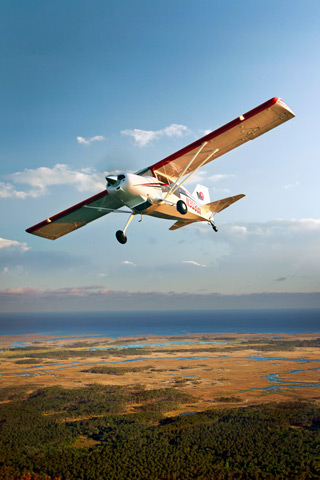
B.D. Maule and his wife, June, celebrated the only golden anniversary they really cared about—their golden wedding anniversary—in 1984.
There was even a sixtieth diamond anniversary. They were married in 1934. B.D. died in 1995 while June died in 2009, but in a way, they didn’t miss the 2012 fiftieth anniversary of the company they created. Both had a role in the design of the M–9-235, the new 235-horsepower model with a gold stripe that represents the golden anniversary of Maule Air.
The term “new model” is relative at Maule in Moultrie, Georgia. The same basic design has lasted 50 years, yet there is a new model number for every tweak. An FAA official once dubbed Maule Air the “Potato Head Factory,” since all models are basically the same—but with a new face, just like the Mr. Potato Head toy.
The $252,900 M–9 comes closest of any to using a different potato. It has a long-sought 300-pound increase in gross weight—actually a 280-pound increase if you subtract the wing stiffeners, thicker wing ribs, and thicker landing gear that were required for the new weight. It also carries 85 gallons of usable fuel. This five-seat tailwheel aircraft with side-by-side seating has a maximum gross weight of 2,800 pounds, the heaviest Maule ever certified on wheels.

The 65-nm formation flight from Moultrie, Georgia, to the Gulf of Mexico paid off—marshlands along the way provided spectacular backdrops (right). The gold stripe on the fuselage and a medalion on the yoke celebrate 50 years of continuous manufacturing (above).
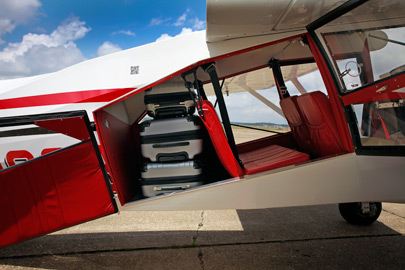
The red, hand-stitched leather interior pays homage to B.D. Maule. “It was like Henry Ford, who said any customer could have any color he wants so long as it is black,” recalls Brent Maule, his grandson and current vice president of sales. “Only his color was red. It is in the black and red company logo as well.”
Other than the changes already mentioned, there is little difference between the new Maule and the previous iteration, the M–7-235C. Both have up to five seats and double doors at the cargo area. Those cargo doors can be removed before flight, causing AOPA photographer Chris Rose to declare the Maule the best photo platform he has ever seen. Well, there is one tiny additional difference. The landing gear is “gun” drilled, meaning there is a hole inside both main aluminum-spring gear running from the fuselage to the wheels, eliminating the need for an external brake line.
“New” is also a relative term. Back in the early 1990s, B.D. Maule participated in the design of the M–9 demonstrator flown for this article. Construction began in 2003, when his widow, June, ran the company. The aircraft attended its first airshow in 2007 as a “prototype.”
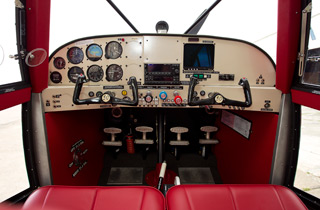
Maule officials say there are many fancier options for the panel than are shown in this demonstrator (below right). This first M-9 was started so many years ago that modern avionics were not yet available. Except for the 300-pound weight increase and a few sturdier parts in the wing and landing gear, the M-9 is not a whole lot different than the M-7 model. Yet it has many more differences than most “new” models of the past.
Despite the economy, “We keep on trucking,” says Brent Maule. An order this year for 10 aircraft slightly surpasses deliveries for last year, although parts sales have sustained the company. Many of those parts are headed to South America, Europe, Russia, and Mongolia.
The Maule has been in continuous production since 1962. Little has changed since the company moved to Moultrie from Napoleon, Michigan.
In the early years at Moultrie, B.D. lifted off inside the present-day hangar and flew out the door to show off his aircraft’s short takeoff capability. One of those takeoffs had a scary moment when he got too high to get out the door.
Changes since then include a new paint booth from Italy that addressed complaints about flaking paint, and a third hangar that has never trembled from the roar of a Maule at full takeoff power.
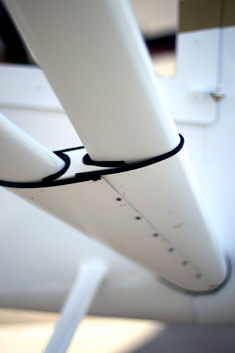
An Irish setter still considers the factory its doghouse, but it isn’t Lady, the dog that followed B.D. Maule everywhere he went. Now it’s Dillon, owned by company employee Mike Jones. Dillon achieved fame by evicting cats from the deteriorating first Maule ever built, which resides in a dusty corner of the factory (see “Cat Smackdown,” page 64). The rocking chairs placed strategically around the factory where B.D. could sit and think are long gone, although his name still appears on the door of his former office, now used by his daughter-in-law, Barbara Maule. A long, narrow lake used by floatplanes and guarded by a swan with anger management problems—and the grass runway next to it—are in daily use. The ramp just outside the factory is still used for takeoffs and landings.
All Maules fly alike, no matter what model. To turn, you lead with the rudder and follow with the ailerons. I remembered that during our two-hour air-to-air photo flight to St. Marks Lighthouse on the Gulf of Mexico, 68 nm to the south. Like the M–9, previous models stall gently and predictably, are stable when flown hands-off, and are economically priced.
There have been improvements over the years. Panels are better organized and sport a modern tan or gray color option, along with modern avionics, although the M–9 demonstrator has analog instruments since construction started nine years ago. Avionics include a PS Engineering PM 1000 II intercom, a JPI EDM 930 engine analyzer, and a Garmin GNC 250XL radio with a Garmin GTX 327 transponder. The hardware-store switches have all but disappeared, except for the radio master switch.
The M–9 is now the truck of the Maule fleet that—when loaded to maximum gross weight—climbs a little slower than the typical Maule at nearly 800 fpm, flies three knots slower at 137 knots true airspeed than the more powerful M–7-260 (260 hp), and requires a few more feet for takeoff (over a 50-foot obstacle). But it has a useful load that, at 1,100 pounds, is 280 pounds greater than that of most M–7 models. While a less-powerful MX–7-180 (180 horsepower) has a useful load only slightly less than that of the M–9, it lacks the performance afforded by the M–9’s more powerful engine.
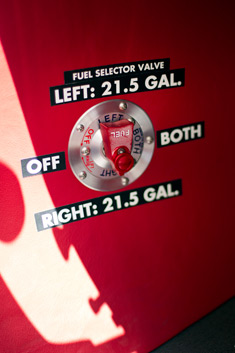
A family of four can take 100 pounds of baggage and still carry 53 gallons of fuel, enough to keep the Lycoming IO-540 engine going for nearly three and one-half hours with a 45-minute reserve. Son Ray Maule said that while the aircraft has a claimed speed of 137 knots true airspeed, he prefers to keep the fuel burn at 12 gallons per hour or less and flight plans for 120 to 125 knots true airspeed. Fewer people flying? Then you can carry the full 85 gallons plus 584 pounds of people or cargo in the cabin. The aircraft has two 21-gallon wingtip tanks. Fuel is transferred to the main tanks by pilot-controlled pumps.
Only the main tanks were needed for our photo flight to the Gulf of Mexico, led by motorcycle and Maule salesman Richard Lane Sr. of Thomasville, Georgia. The flight had been delayed by weather, leaving time during our last morning at the plant to capture takeoffs and landings on video. Lightly loaded, they were accomplished in 500 feet.
“You put on quite a show,” a worker told Ray Maule. Dillon, watching from the shade outside the hangar door, seemed to approve as well and headed inside—ever vigilant for cats that think they are pilots.
Email [email protected]
SPEC SHEET
Maule M–9-235
Base price: $252,900
Price as tested: $285,000
SPECIFICATIONS
Powerplant | Lycoming IO-540-W1A5, 235 hp @ 2,400 rpm
Recommended TBO | 2,000 hr
Propeller | McCauley 3-blade 80 in. dia constant speed
Length | 23 ft 8 in
Height | 6 ft 3 in
Wingspan | 32 ft 11 in
Wing area | 165.6 sq ft
Wing loading | 16.9 lb/sq ft
Power loading | 11.9 lb/hp
Seats | 5
Cabin length | 8 ft 3 in
Cabin width | 3 ft 6 in
Cabin height | 3 ft 8 in
Empty weight | 1,700 lb
Empty weight, as tested | 1,706 lb
Max gross weight | 2,800 lb
Useful load | 1,100 lb
Useful load, as tested | 1,094 lb
Payload w/full fuel | 590 lb
Payload w/full fuel, as tested | 584 lb
Fuel capacity, std | 89.6 gal (85 gal usable)
537.6 lb (510 lb usable)
Baggage capacity | 170 lb
PERFORMANCE
Takeoff distance, ground roll | 406 ft
Takeoff distance over 50-ft obstacle | 791 ft
Max demonstrated crosswind component | 12 kt
Rate of climb, sea level | 800 fpm
Cruise speed/endurance w/45-min rsv, std fuel
(fuel consumption)
@ 75% power, best economy | 137 kt/5.7 hr
7,500 ft | (78 pph/13 gph)
@ 65% power, best economy | 122 kt/6.2 hr
7,500 ft | (72 pph/12 gph)
Service ceiling | 20,000 ft
Landing distance over 50-ft obstacle | 900 ft
Landing distance, ground roll | 250 ft
Limiting and Recommended Airspeeds
VX (best angle of climb) | 65 KIAS
VY (best rate of climb) | 78 KIAS
VA (design maneuvering) | 109 KIAS
VFE (max flap extended) | 82 KIAS
VNO (max structural cruising) | 126 KIAS
VNE (never exceed) | 156 KIAS
VS1 (stall, clean) | 53 KIAS
VSO (stall, in landing configuration) | 43 KIAS
For more information
Maule Air, 2099 Georgia Highway
133 South, Moultrie, Georgia 31768;
telephone 229/985-2045;
www.maulairinc.com;
email [email protected].
All specifications are based on manufacturer’s calculations. All performance figures are based on standard day, standard atmosphere, sea level, maximum gross weight conditions unless otherwise noted.
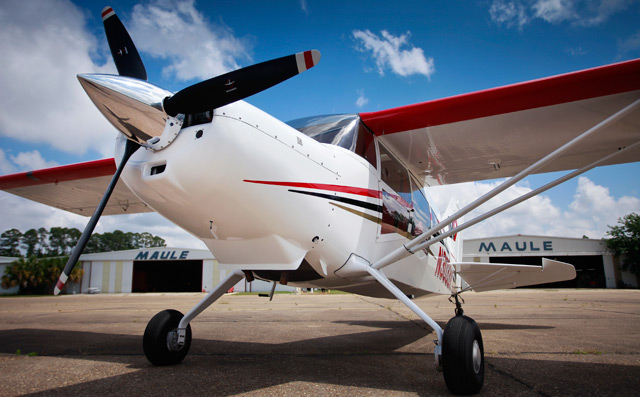
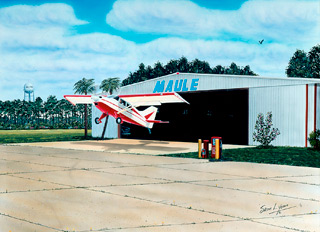
Takes off like a rocket
B.D. Maule was known to have lifted off inside the present-day factory, flying out the door to show off his aircraft’s short takeoff capability. His feat was captured in a limited-edition painting by aviation artist Sam Lyons that hangs on an office wall (above).
One of those takeoffs had a scary moment when he got too high to get out the door, but he descended just in time, grandson Brent Maule said.
Only one of the factory’s three hangar-like buildings has never heard the roar of a Maule at takeoff power. A new paint booth from Italy that answered complaints about flaking paint has shortened the “runway” length inside one of the two buildings. The other is a little cluttered with 10 aircraft under construction.
B.D. Maule always referred to his airplanes as rockets, and one of them nearly tore the roof off.
Sam lyons painting courtesy lyonsstudio.com

Cat Smackdown!
Dillon, the resident Irish setter, achieved fame by evicting cats from the deteriorating first Maule ever built.
June Maule had directed that the aircraft not be restored lest something happen to it in flight, and so it sat in a dusty corner, attracting cats. One day Brent Maule happened to spot cat paw prints in the dust on top of the fuselage, and decided to open the door to see if they were inside.
Just coming up behind him at that time was Dillon. As soon as the door was open, Dillon shot inside and served an eviction notice. The ruckus took a while, but the cats agreed it was in their best interest to give up squatter’s rights.

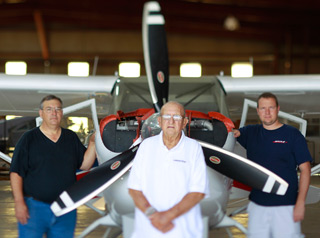
Founder B.D. Maule (left). You’ll find a lot of people named Maule in the factory. At right is (from left to right), company president David Maule, test pilot and treasurer Ray Maule, and marketing vice president Brent Maule.



